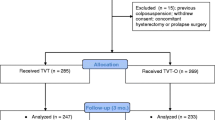Abstract
Introduction and hypothesis
This study aimed to prospectively compare, in terms of efficacy and safety, the tension-free vaginal tape (TVT) and the transobturator vaginal tape inside-out (TVT-O) procedure for stress urinary incontinence.
Methods
A cough stress test was applied to the objective outcomes, while urinary incontinence-specific quality of life questionnaire was applied to the subjective outcomes. A test for non-inferiority was carried out for detecting the success rate between the two groups.
Results
The objective success rates were found to be 95.4% (62/65) in the TVT group and 96.4% (108/112) in the TVT-O group. No significant difference was found between these two groups in the success rate by non-inferiority test (P < 0.0005), with significant improvement in quality of life and no significant difference in patient satisfaction rates in the two groups (P > 0.05).
Conclusions
In the study, the TVT-O procedure could be defined to be identical to the TVT approach in success rate by non-inferiority test.
Similar content being viewed by others
References
Deffieux X et al (2010) Transobturator TVT-O versus retropubic TVT: results of a multicenter randomized controlled trial at 24 months follow-up. Int Urogynecol J Pelvic Floor Dysfunct 21(11):1337–1345
Krofta L et al (2010) TVT and TVT-O for surgical treatment of primary stress urinary incontinence: prospective randomized trial. Int Urogynecol J Pelvic Floor Dysfunct 21(2):141–148
Tommaselli GA et al (2010) Efficacy and safety of TVT-O and TVT-Secur in the treatment of female stress urinary incontinence: 1-year follow-up. Int Urogynecol J Pelvic Floor Dysfunct 21(10):1211–1217
de Leval J (2003) Novel surgical technique for the treatment of female stress urinary incontinence: transobturator vaginal tape inside-out. Eur Urol 44(6):724–730
Ulmsten U et al (1996) An ambulatory surgical procedure under local anesthesia for treatment of female urinary incontinence. Int Urogynecol J Pelvic Floor Dysfunct 7(2):81–85, discussion 85–6
Bushnell DM et al (2005) Quality of life of women with urinary incontinence: cross-cultural performance of 15 language versions of the I-QOL. Qual Life Res 14(8):1901–1913
Lee KS et al (2008) Prospective comparison of the ‘inside-out’ and ‘outside-in’ transobturator-tape procedures for the treatment of female stress urinary incontinence. Int Urogynecol J Pelvic Floor Dysfunct 19(4):577–582
Abrams P et al (2010) Fourth International Consultation on Incontinence Recommendations of the International Scientific Committee: evaluation and treatment of urinary incontinence, pelvic organ prolapse, and fecal incontinence. Neurourol Urodyn 29(1):213–240
Rinne K et al (2008) A randomized trial comparing TVT with TVT-O: 12-month results. Int Urogynecol J Pelvic Floor Dysfunct 19(8):1049–1054
Mellier G et al (2004) Suburethral tape via the obturator route: is the TOT a simplification of the TVT? Int Urogynecol J Pelvic Floor Dysfunct 15(4):227–232
Liapis A, Bakas P, Creatsas G (2002) Burch colposuspension and tension-free vaginal tape in the management of stress urinary incontinence in women. Eur Urol 41(4):469–473
Karateke A et al (2009) Comparison of TVT and TVT-O in patients with stress urinary incontinence: short-term cure rates and factors influencing the outcome. A prospective randomised study. Aust N Z J Obstet Gynaecol 49(1):99–105
Zullo MA et al (2007) One-year follow-up of tension-free vaginal tape (TVT) and trans-obturator suburethral tape from inside to outside (TVT-O) for surgical treatment of female stress urinary incontinence: a prospective randomised trial. Eur Urol 51(5):1376–1382, discussion 1383–4
Liapis A et al (2006) Tension-free vaginal tape versus tension-free vaginal tape obturator in women with stress urinary incontinence. Gynecol Obstet Invest 62(3):160–164
Dietz HP et al (2006) TVT vs Monarc: a comparative study. Int Urogynecol J Pelvic Floor Dysfunct 17(6):566–569
Ward KL, Hilton P (2004) A prospective multicenter randomized trial of tension-free vaginal tape and colposuspension for primary urodynamic stress incontinence: two-year follow-up. Am J Obstet Gynecol 190(2):324–331
Descazeaud A et al (2007) TVT-O treatment of stress urinary incontinence: immediate and one-year results. Gynecol Obstet Fertil 35(6):523–529
Sola V et al (2007) TVT versus TVT-O for minimally invasive surgical correction of stress urinary incontinence. Int Braz J Urol 33(2):246–252, discussion 253
Boustead GB (2002) The tension-free vaginal tape for treating female stress urinary incontinence. BJU Int 89(7):687–693
Meschia M et al (2007) Peri-operative morbidity and early results of a randomised trial comparing TVT and TVT-O. Int Urogynecol J Pelvic Floor Dysfunct 18(11):1257–1261
Araco F et al (2008) TVT-O vs TVT: a randomized trial in patients with different degrees of urinary stress incontinence. Int Urogynecol J Pelvic Floor Dysfunct 19(7):917–926
Acknowledgments
This study was supported by the National Natural Science Foundation of China (no. 30471815). The authors wish to express appreciation to Yongfeng Zhao, Junhua Liang, Xia Jin, and Lei Chu for their efforts in data collection and to Bozhen Fan, Li Li, and Jianjun Wang for their constant support.
Conflicts of interest
None.
Author information
Authors and Affiliations
Corresponding author
Additional information
This study was conducted in the city of Shanghai, China.
Rights and permissions
About this article
Cite this article
Yang, X., Jiang, M., Chen, X. et al. TVT-O vs. TVT for the treatment of SUI: a non-inferiority study. Int Urogynecol J 23, 99–104 (2012). https://doi.org/10.1007/s00192-011-1537-6
Received:
Accepted:
Published:
Issue Date:
DOI: https://doi.org/10.1007/s00192-011-1537-6




